Assignment on Aspects of Employment Law
VerifiedAdded on 2020/04/15
|15
|4052
|46
AI Summary
Contribute Materials
Your contribution can guide someone’s learning journey. Share your
documents today.

Secure Best Marks with AI Grader
Need help grading? Try our AI Grader for instant feedback on your assignments.
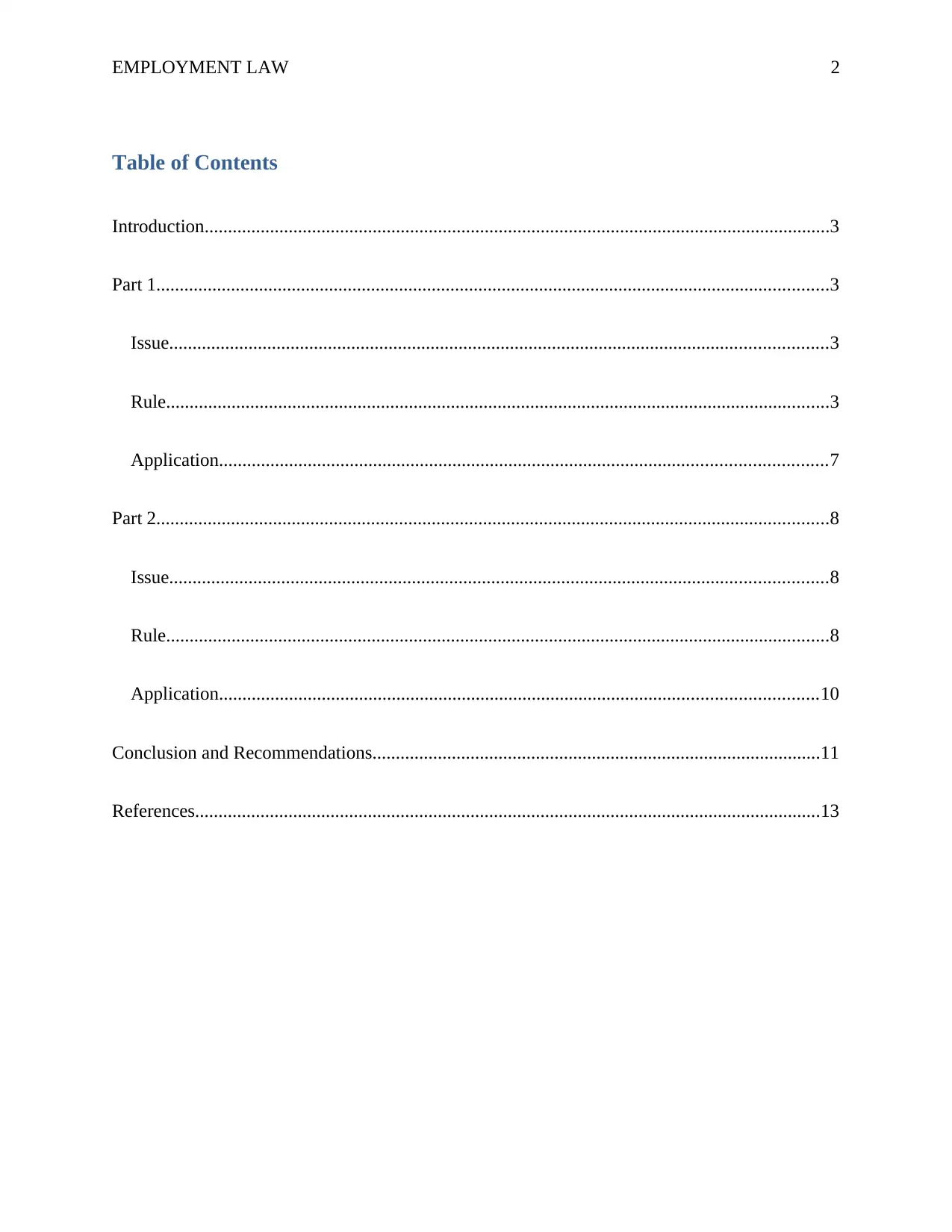
EMPLOYMENT LAW 2
Table of Contents
Introduction......................................................................................................................................3
Part 1................................................................................................................................................3
Issue.............................................................................................................................................3
Rule..............................................................................................................................................3
Application..................................................................................................................................7
Part 2................................................................................................................................................8
Issue.............................................................................................................................................8
Rule..............................................................................................................................................8
Application................................................................................................................................10
Conclusion and Recommendations................................................................................................11
References......................................................................................................................................13
Table of Contents
Introduction......................................................................................................................................3
Part 1................................................................................................................................................3
Issue.............................................................................................................................................3
Rule..............................................................................................................................................3
Application..................................................................................................................................7
Part 2................................................................................................................................................8
Issue.............................................................................................................................................8
Rule..............................................................................................................................................8
Application................................................................................................................................10
Conclusion and Recommendations................................................................................................11
References......................................................................................................................................13
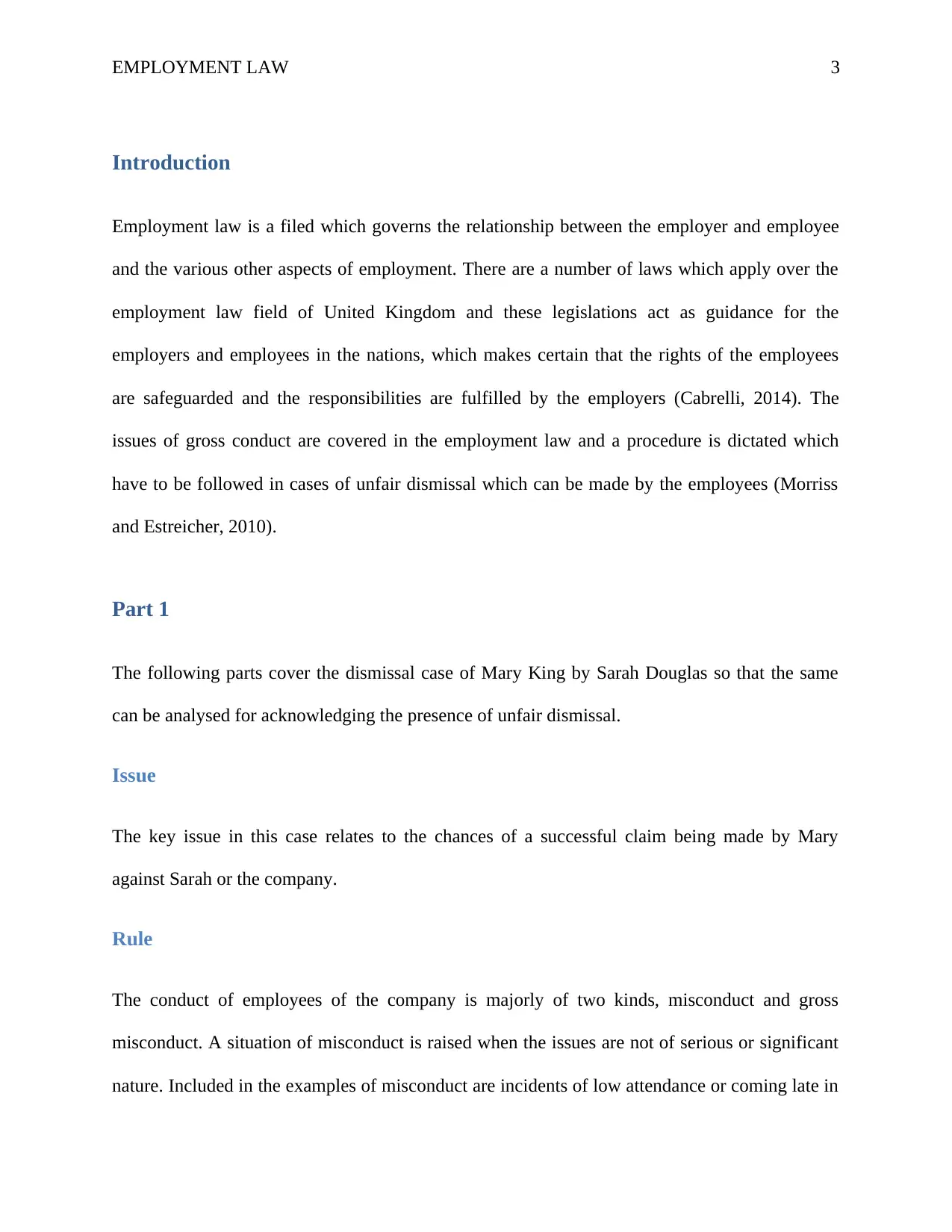
EMPLOYMENT LAW 3
Introduction
Employment law is a filed which governs the relationship between the employer and employee
and the various other aspects of employment. There are a number of laws which apply over the
employment law field of United Kingdom and these legislations act as guidance for the
employers and employees in the nations, which makes certain that the rights of the employees
are safeguarded and the responsibilities are fulfilled by the employers (Cabrelli, 2014). The
issues of gross conduct are covered in the employment law and a procedure is dictated which
have to be followed in cases of unfair dismissal which can be made by the employees (Morriss
and Estreicher, 2010).
Part 1
The following parts cover the dismissal case of Mary King by Sarah Douglas so that the same
can be analysed for acknowledging the presence of unfair dismissal.
Issue
The key issue in this case relates to the chances of a successful claim being made by Mary
against Sarah or the company.
Rule
The conduct of employees of the company is majorly of two kinds, misconduct and gross
misconduct. A situation of misconduct is raised when the issues are not of serious or significant
nature. Included in the examples of misconduct are incidents of low attendance or coming late in
Introduction
Employment law is a filed which governs the relationship between the employer and employee
and the various other aspects of employment. There are a number of laws which apply over the
employment law field of United Kingdom and these legislations act as guidance for the
employers and employees in the nations, which makes certain that the rights of the employees
are safeguarded and the responsibilities are fulfilled by the employers (Cabrelli, 2014). The
issues of gross conduct are covered in the employment law and a procedure is dictated which
have to be followed in cases of unfair dismissal which can be made by the employees (Morriss
and Estreicher, 2010).
Part 1
The following parts cover the dismissal case of Mary King by Sarah Douglas so that the same
can be analysed for acknowledging the presence of unfair dismissal.
Issue
The key issue in this case relates to the chances of a successful claim being made by Mary
against Sarah or the company.
Rule
The conduct of employees of the company is majorly of two kinds, misconduct and gross
misconduct. A situation of misconduct is raised when the issues are not of serious or significant
nature. Included in the examples of misconduct are incidents of low attendance or coming late in
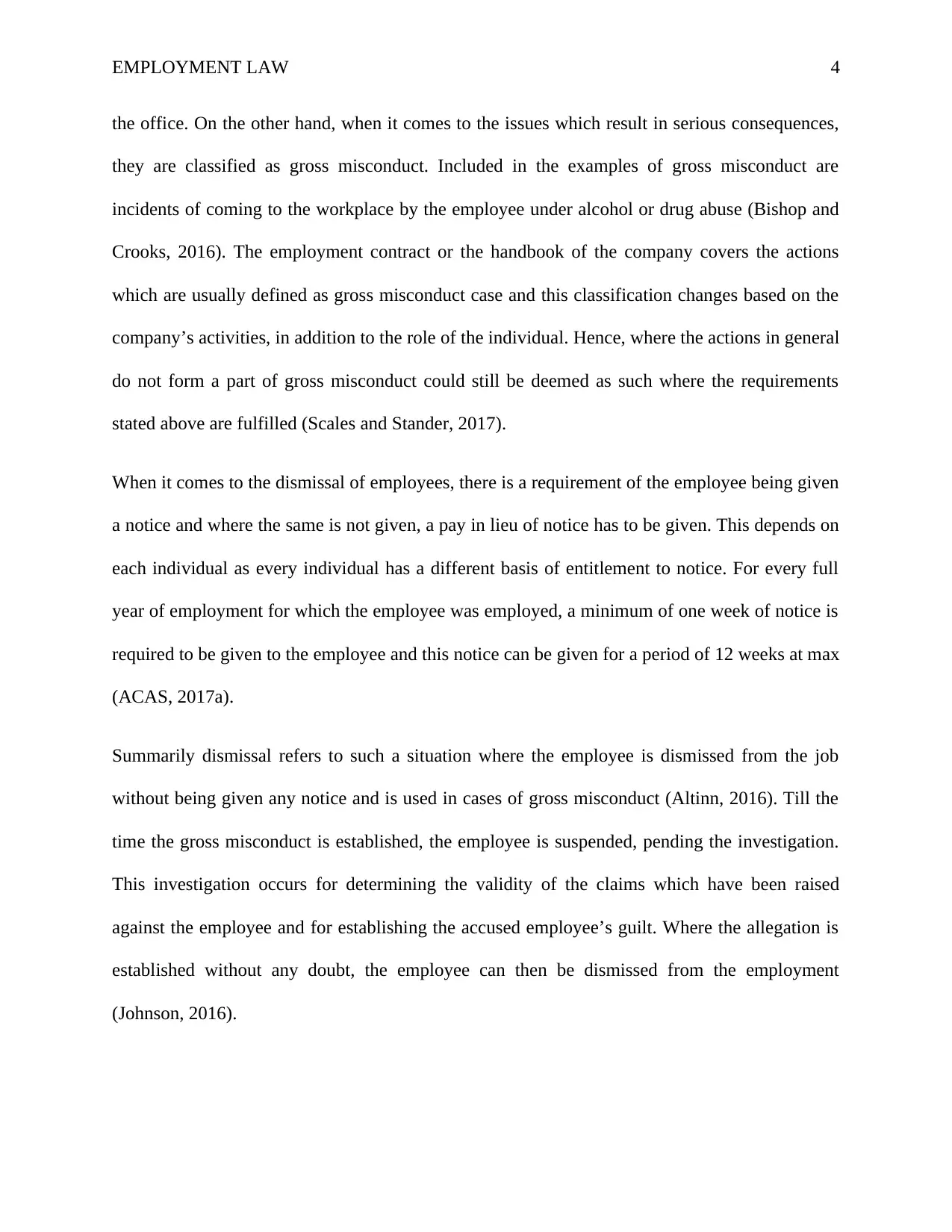
EMPLOYMENT LAW 4
the office. On the other hand, when it comes to the issues which result in serious consequences,
they are classified as gross misconduct. Included in the examples of gross misconduct are
incidents of coming to the workplace by the employee under alcohol or drug abuse (Bishop and
Crooks, 2016). The employment contract or the handbook of the company covers the actions
which are usually defined as gross misconduct case and this classification changes based on the
company’s activities, in addition to the role of the individual. Hence, where the actions in general
do not form a part of gross misconduct could still be deemed as such where the requirements
stated above are fulfilled (Scales and Stander, 2017).
When it comes to the dismissal of employees, there is a requirement of the employee being given
a notice and where the same is not given, a pay in lieu of notice has to be given. This depends on
each individual as every individual has a different basis of entitlement to notice. For every full
year of employment for which the employee was employed, a minimum of one week of notice is
required to be given to the employee and this notice can be given for a period of 12 weeks at max
(ACAS, 2017a).
Summarily dismissal refers to such a situation where the employee is dismissed from the job
without being given any notice and is used in cases of gross misconduct (Altinn, 2016). Till the
time the gross misconduct is established, the employee is suspended, pending the investigation.
This investigation occurs for determining the validity of the claims which have been raised
against the employee and for establishing the accused employee’s guilt. Where the allegation is
established without any doubt, the employee can then be dismissed from the employment
(Johnson, 2016).
the office. On the other hand, when it comes to the issues which result in serious consequences,
they are classified as gross misconduct. Included in the examples of gross misconduct are
incidents of coming to the workplace by the employee under alcohol or drug abuse (Bishop and
Crooks, 2016). The employment contract or the handbook of the company covers the actions
which are usually defined as gross misconduct case and this classification changes based on the
company’s activities, in addition to the role of the individual. Hence, where the actions in general
do not form a part of gross misconduct could still be deemed as such where the requirements
stated above are fulfilled (Scales and Stander, 2017).
When it comes to the dismissal of employees, there is a requirement of the employee being given
a notice and where the same is not given, a pay in lieu of notice has to be given. This depends on
each individual as every individual has a different basis of entitlement to notice. For every full
year of employment for which the employee was employed, a minimum of one week of notice is
required to be given to the employee and this notice can be given for a period of 12 weeks at max
(ACAS, 2017a).
Summarily dismissal refers to such a situation where the employee is dismissed from the job
without being given any notice and is used in cases of gross misconduct (Altinn, 2016). Till the
time the gross misconduct is established, the employee is suspended, pending the investigation.
This investigation occurs for determining the validity of the claims which have been raised
against the employee and for establishing the accused employee’s guilt. Where the allegation is
established without any doubt, the employee can then be dismissed from the employment
(Johnson, 2016).
Secure Best Marks with AI Grader
Need help grading? Try our AI Grader for instant feedback on your assignments.
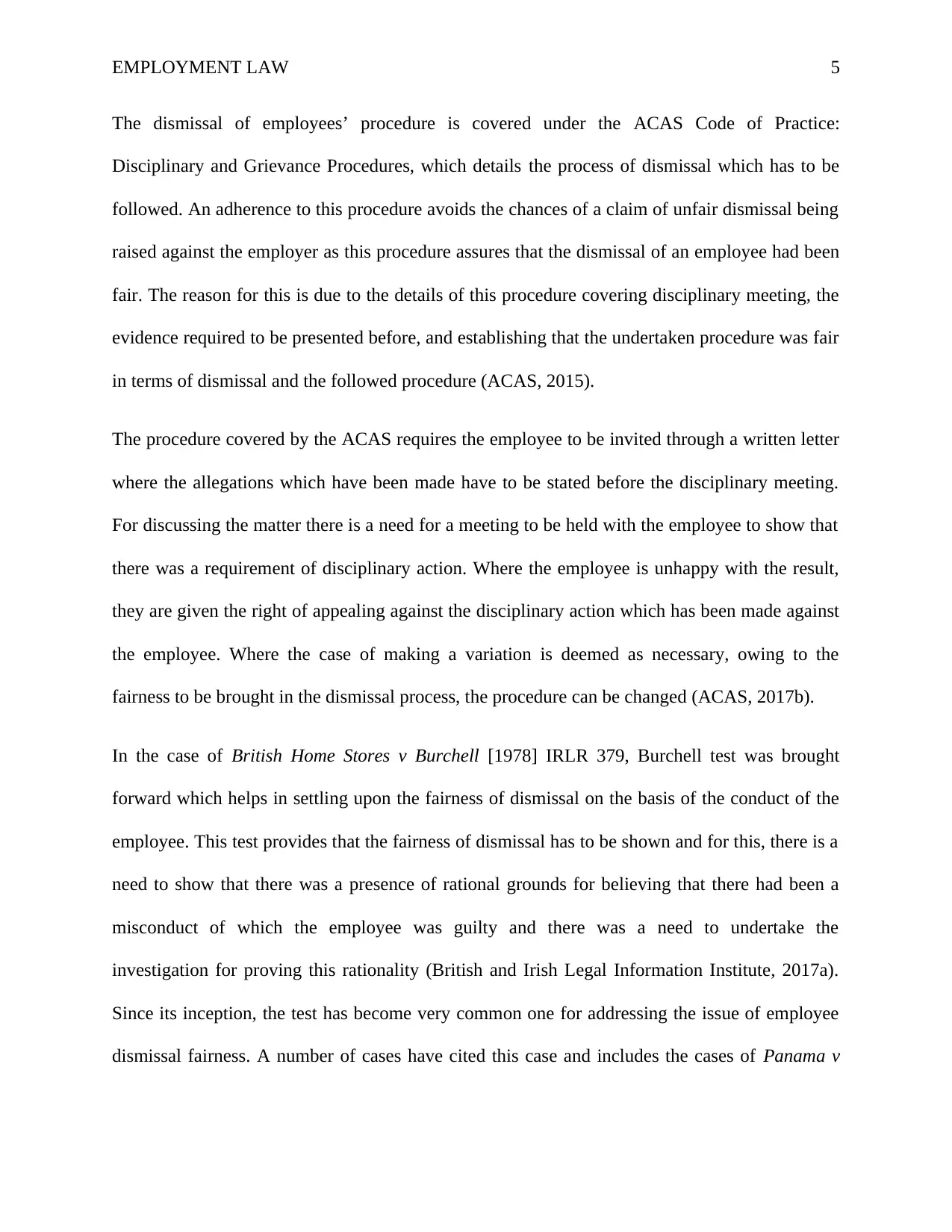
EMPLOYMENT LAW 5
The dismissal of employees’ procedure is covered under the ACAS Code of Practice:
Disciplinary and Grievance Procedures, which details the process of dismissal which has to be
followed. An adherence to this procedure avoids the chances of a claim of unfair dismissal being
raised against the employer as this procedure assures that the dismissal of an employee had been
fair. The reason for this is due to the details of this procedure covering disciplinary meeting, the
evidence required to be presented before, and establishing that the undertaken procedure was fair
in terms of dismissal and the followed procedure (ACAS, 2015).
The procedure covered by the ACAS requires the employee to be invited through a written letter
where the allegations which have been made have to be stated before the disciplinary meeting.
For discussing the matter there is a need for a meeting to be held with the employee to show that
there was a requirement of disciplinary action. Where the employee is unhappy with the result,
they are given the right of appealing against the disciplinary action which has been made against
the employee. Where the case of making a variation is deemed as necessary, owing to the
fairness to be brought in the dismissal process, the procedure can be changed (ACAS, 2017b).
In the case of British Home Stores v Burchell [1978] IRLR 379, Burchell test was brought
forward which helps in settling upon the fairness of dismissal on the basis of the conduct of the
employee. This test provides that the fairness of dismissal has to be shown and for this, there is a
need to show that there was a presence of rational grounds for believing that there had been a
misconduct of which the employee was guilty and there was a need to undertake the
investigation for proving this rationality (British and Irish Legal Information Institute, 2017a).
Since its inception, the test has become very common one for addressing the issue of employee
dismissal fairness. A number of cases have cited this case and includes the cases of Panama v
The dismissal of employees’ procedure is covered under the ACAS Code of Practice:
Disciplinary and Grievance Procedures, which details the process of dismissal which has to be
followed. An adherence to this procedure avoids the chances of a claim of unfair dismissal being
raised against the employer as this procedure assures that the dismissal of an employee had been
fair. The reason for this is due to the details of this procedure covering disciplinary meeting, the
evidence required to be presented before, and establishing that the undertaken procedure was fair
in terms of dismissal and the followed procedure (ACAS, 2015).
The procedure covered by the ACAS requires the employee to be invited through a written letter
where the allegations which have been made have to be stated before the disciplinary meeting.
For discussing the matter there is a need for a meeting to be held with the employee to show that
there was a requirement of disciplinary action. Where the employee is unhappy with the result,
they are given the right of appealing against the disciplinary action which has been made against
the employee. Where the case of making a variation is deemed as necessary, owing to the
fairness to be brought in the dismissal process, the procedure can be changed (ACAS, 2017b).
In the case of British Home Stores v Burchell [1978] IRLR 379, Burchell test was brought
forward which helps in settling upon the fairness of dismissal on the basis of the conduct of the
employee. This test provides that the fairness of dismissal has to be shown and for this, there is a
need to show that there was a presence of rational grounds for believing that there had been a
misconduct of which the employee was guilty and there was a need to undertake the
investigation for proving this rationality (British and Irish Legal Information Institute, 2017a).
Since its inception, the test has become very common one for addressing the issue of employee
dismissal fairness. A number of cases have cited this case and includes the cases of Panama v
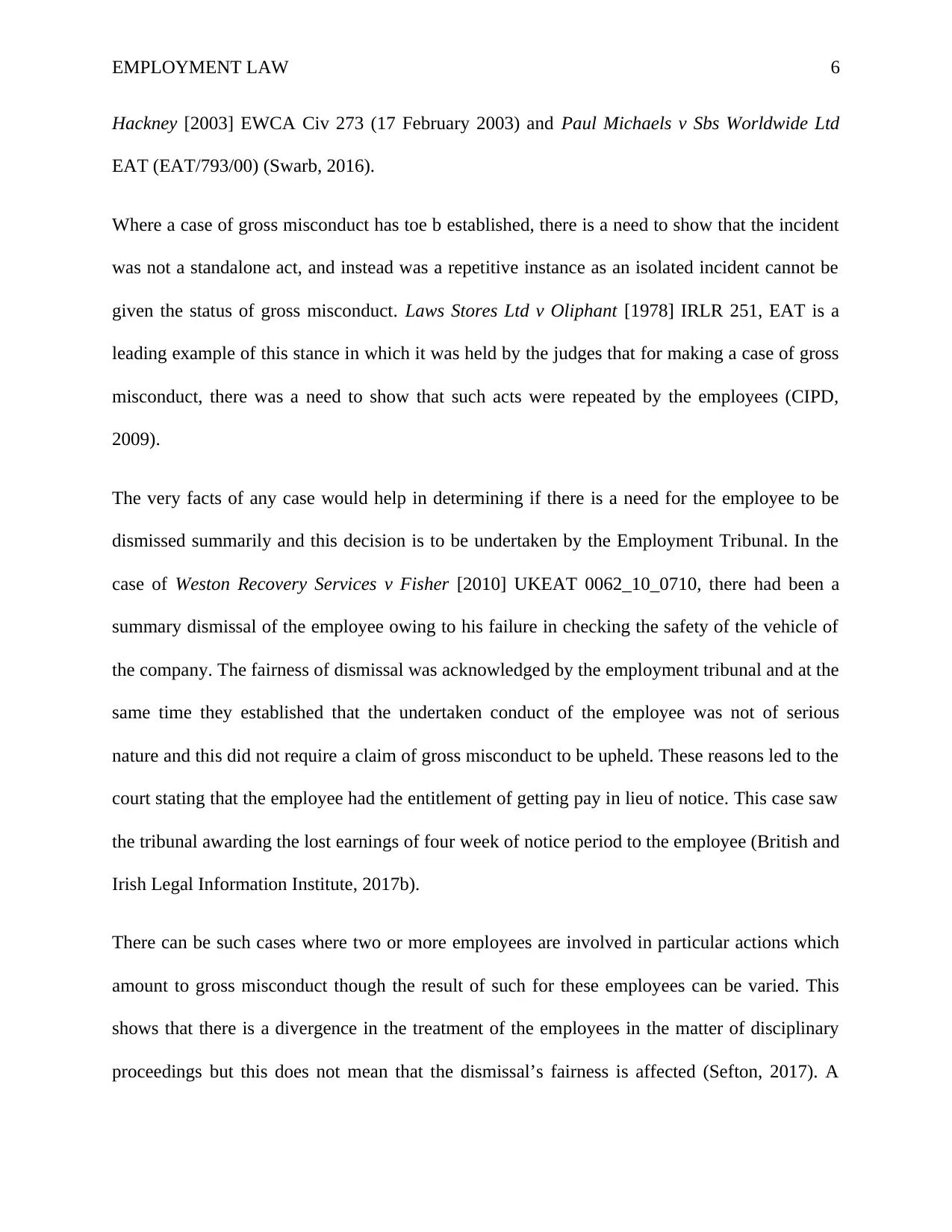
EMPLOYMENT LAW 6
Hackney [2003] EWCA Civ 273 (17 February 2003) and Paul Michaels v Sbs Worldwide Ltd
EAT (EAT/793/00) (Swarb, 2016).
Where a case of gross misconduct has toe b established, there is a need to show that the incident
was not a standalone act, and instead was a repetitive instance as an isolated incident cannot be
given the status of gross misconduct. Laws Stores Ltd v Oliphant [1978] IRLR 251, EAT is a
leading example of this stance in which it was held by the judges that for making a case of gross
misconduct, there was a need to show that such acts were repeated by the employees (CIPD,
2009).
The very facts of any case would help in determining if there is a need for the employee to be
dismissed summarily and this decision is to be undertaken by the Employment Tribunal. In the
case of Weston Recovery Services v Fisher [2010] UKEAT 0062_10_0710, there had been a
summary dismissal of the employee owing to his failure in checking the safety of the vehicle of
the company. The fairness of dismissal was acknowledged by the employment tribunal and at the
same time they established that the undertaken conduct of the employee was not of serious
nature and this did not require a claim of gross misconduct to be upheld. These reasons led to the
court stating that the employee had the entitlement of getting pay in lieu of notice. This case saw
the tribunal awarding the lost earnings of four week of notice period to the employee (British and
Irish Legal Information Institute, 2017b).
There can be such cases where two or more employees are involved in particular actions which
amount to gross misconduct though the result of such for these employees can be varied. This
shows that there is a divergence in the treatment of the employees in the matter of disciplinary
proceedings but this does not mean that the dismissal’s fairness is affected (Sefton, 2017). A
Hackney [2003] EWCA Civ 273 (17 February 2003) and Paul Michaels v Sbs Worldwide Ltd
EAT (EAT/793/00) (Swarb, 2016).
Where a case of gross misconduct has toe b established, there is a need to show that the incident
was not a standalone act, and instead was a repetitive instance as an isolated incident cannot be
given the status of gross misconduct. Laws Stores Ltd v Oliphant [1978] IRLR 251, EAT is a
leading example of this stance in which it was held by the judges that for making a case of gross
misconduct, there was a need to show that such acts were repeated by the employees (CIPD,
2009).
The very facts of any case would help in determining if there is a need for the employee to be
dismissed summarily and this decision is to be undertaken by the Employment Tribunal. In the
case of Weston Recovery Services v Fisher [2010] UKEAT 0062_10_0710, there had been a
summary dismissal of the employee owing to his failure in checking the safety of the vehicle of
the company. The fairness of dismissal was acknowledged by the employment tribunal and at the
same time they established that the undertaken conduct of the employee was not of serious
nature and this did not require a claim of gross misconduct to be upheld. These reasons led to the
court stating that the employee had the entitlement of getting pay in lieu of notice. This case saw
the tribunal awarding the lost earnings of four week of notice period to the employee (British and
Irish Legal Information Institute, 2017b).
There can be such cases where two or more employees are involved in particular actions which
amount to gross misconduct though the result of such for these employees can be varied. This
shows that there is a divergence in the treatment of the employees in the matter of disciplinary
proceedings but this does not mean that the dismissal’s fairness is affected (Sefton, 2017). A
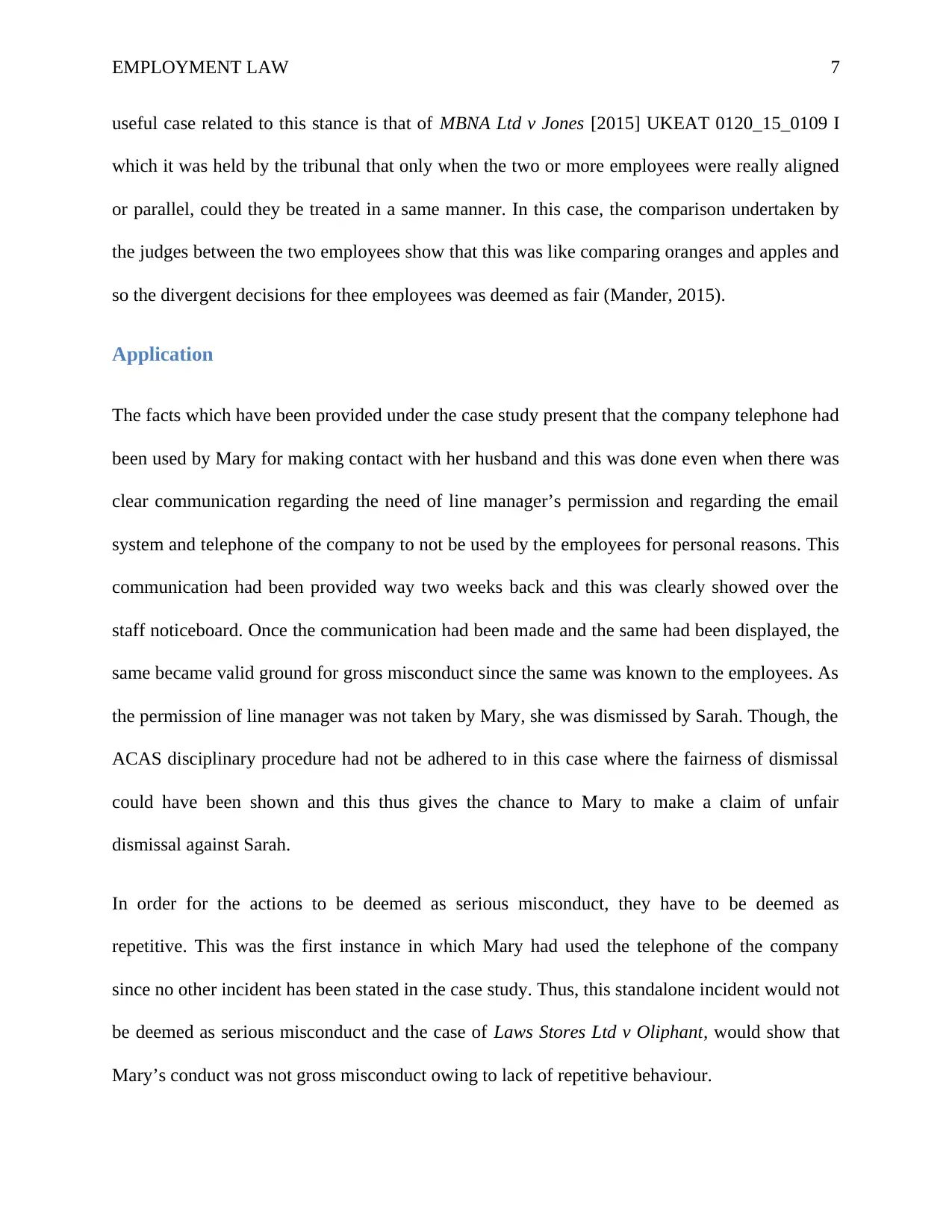
EMPLOYMENT LAW 7
useful case related to this stance is that of MBNA Ltd v Jones [2015] UKEAT 0120_15_0109 I
which it was held by the tribunal that only when the two or more employees were really aligned
or parallel, could they be treated in a same manner. In this case, the comparison undertaken by
the judges between the two employees show that this was like comparing oranges and apples and
so the divergent decisions for thee employees was deemed as fair (Mander, 2015).
Application
The facts which have been provided under the case study present that the company telephone had
been used by Mary for making contact with her husband and this was done even when there was
clear communication regarding the need of line manager’s permission and regarding the email
system and telephone of the company to not be used by the employees for personal reasons. This
communication had been provided way two weeks back and this was clearly showed over the
staff noticeboard. Once the communication had been made and the same had been displayed, the
same became valid ground for gross misconduct since the same was known to the employees. As
the permission of line manager was not taken by Mary, she was dismissed by Sarah. Though, the
ACAS disciplinary procedure had not be adhered to in this case where the fairness of dismissal
could have been shown and this thus gives the chance to Mary to make a claim of unfair
dismissal against Sarah.
In order for the actions to be deemed as serious misconduct, they have to be deemed as
repetitive. This was the first instance in which Mary had used the telephone of the company
since no other incident has been stated in the case study. Thus, this standalone incident would not
be deemed as serious misconduct and the case of Laws Stores Ltd v Oliphant, would show that
Mary’s conduct was not gross misconduct owing to lack of repetitive behaviour.
useful case related to this stance is that of MBNA Ltd v Jones [2015] UKEAT 0120_15_0109 I
which it was held by the tribunal that only when the two or more employees were really aligned
or parallel, could they be treated in a same manner. In this case, the comparison undertaken by
the judges between the two employees show that this was like comparing oranges and apples and
so the divergent decisions for thee employees was deemed as fair (Mander, 2015).
Application
The facts which have been provided under the case study present that the company telephone had
been used by Mary for making contact with her husband and this was done even when there was
clear communication regarding the need of line manager’s permission and regarding the email
system and telephone of the company to not be used by the employees for personal reasons. This
communication had been provided way two weeks back and this was clearly showed over the
staff noticeboard. Once the communication had been made and the same had been displayed, the
same became valid ground for gross misconduct since the same was known to the employees. As
the permission of line manager was not taken by Mary, she was dismissed by Sarah. Though, the
ACAS disciplinary procedure had not be adhered to in this case where the fairness of dismissal
could have been shown and this thus gives the chance to Mary to make a claim of unfair
dismissal against Sarah.
In order for the actions to be deemed as serious misconduct, they have to be deemed as
repetitive. This was the first instance in which Mary had used the telephone of the company
since no other incident has been stated in the case study. Thus, this standalone incident would not
be deemed as serious misconduct and the case of Laws Stores Ltd v Oliphant, would show that
Mary’s conduct was not gross misconduct owing to lack of repetitive behaviour.
Paraphrase This Document
Need a fresh take? Get an instant paraphrase of this document with our AI Paraphraser
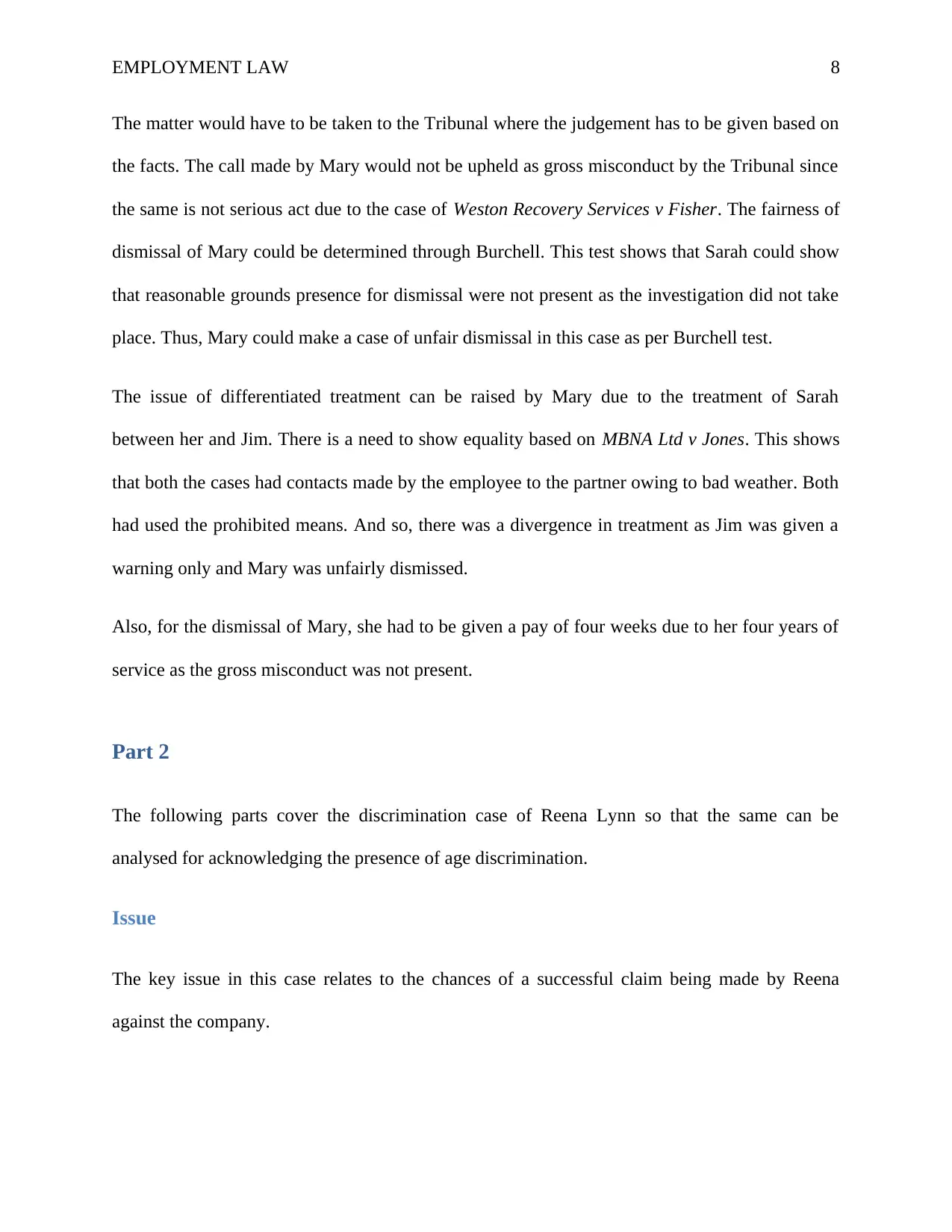
EMPLOYMENT LAW 8
The matter would have to be taken to the Tribunal where the judgement has to be given based on
the facts. The call made by Mary would not be upheld as gross misconduct by the Tribunal since
the same is not serious act due to the case of Weston Recovery Services v Fisher. The fairness of
dismissal of Mary could be determined through Burchell. This test shows that Sarah could show
that reasonable grounds presence for dismissal were not present as the investigation did not take
place. Thus, Mary could make a case of unfair dismissal in this case as per Burchell test.
The issue of differentiated treatment can be raised by Mary due to the treatment of Sarah
between her and Jim. There is a need to show equality based on MBNA Ltd v Jones. This shows
that both the cases had contacts made by the employee to the partner owing to bad weather. Both
had used the prohibited means. And so, there was a divergence in treatment as Jim was given a
warning only and Mary was unfairly dismissed.
Also, for the dismissal of Mary, she had to be given a pay of four weeks due to her four years of
service as the gross misconduct was not present.
Part 2
The following parts cover the discrimination case of Reena Lynn so that the same can be
analysed for acknowledging the presence of age discrimination.
Issue
The key issue in this case relates to the chances of a successful claim being made by Reena
against the company.
The matter would have to be taken to the Tribunal where the judgement has to be given based on
the facts. The call made by Mary would not be upheld as gross misconduct by the Tribunal since
the same is not serious act due to the case of Weston Recovery Services v Fisher. The fairness of
dismissal of Mary could be determined through Burchell. This test shows that Sarah could show
that reasonable grounds presence for dismissal were not present as the investigation did not take
place. Thus, Mary could make a case of unfair dismissal in this case as per Burchell test.
The issue of differentiated treatment can be raised by Mary due to the treatment of Sarah
between her and Jim. There is a need to show equality based on MBNA Ltd v Jones. This shows
that both the cases had contacts made by the employee to the partner owing to bad weather. Both
had used the prohibited means. And so, there was a divergence in treatment as Jim was given a
warning only and Mary was unfairly dismissed.
Also, for the dismissal of Mary, she had to be given a pay of four weeks due to her four years of
service as the gross misconduct was not present.
Part 2
The following parts cover the discrimination case of Reena Lynn so that the same can be
analysed for acknowledging the presence of age discrimination.
Issue
The key issue in this case relates to the chances of a successful claim being made by Reena
against the company.
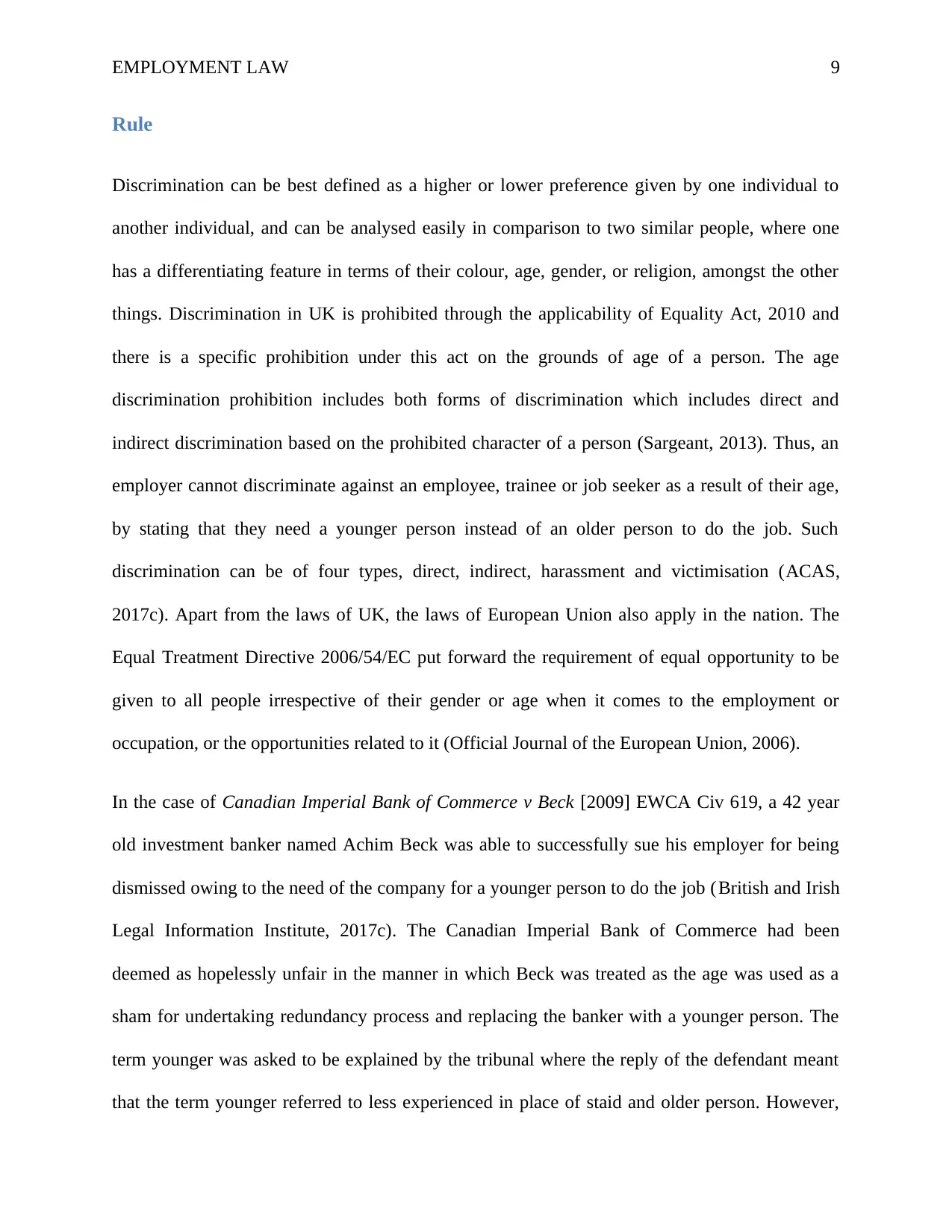
EMPLOYMENT LAW 9
Rule
Discrimination can be best defined as a higher or lower preference given by one individual to
another individual, and can be analysed easily in comparison to two similar people, where one
has a differentiating feature in terms of their colour, age, gender, or religion, amongst the other
things. Discrimination in UK is prohibited through the applicability of Equality Act, 2010 and
there is a specific prohibition under this act on the grounds of age of a person. The age
discrimination prohibition includes both forms of discrimination which includes direct and
indirect discrimination based on the prohibited character of a person (Sargeant, 2013). Thus, an
employer cannot discriminate against an employee, trainee or job seeker as a result of their age,
by stating that they need a younger person instead of an older person to do the job. Such
discrimination can be of four types, direct, indirect, harassment and victimisation (ACAS,
2017c). Apart from the laws of UK, the laws of European Union also apply in the nation. The
Equal Treatment Directive 2006/54/EC put forward the requirement of equal opportunity to be
given to all people irrespective of their gender or age when it comes to the employment or
occupation, or the opportunities related to it (Official Journal of the European Union, 2006).
In the case of Canadian Imperial Bank of Commerce v Beck [2009] EWCA Civ 619, a 42 year
old investment banker named Achim Beck was able to successfully sue his employer for being
dismissed owing to the need of the company for a younger person to do the job (British and Irish
Legal Information Institute, 2017c). The Canadian Imperial Bank of Commerce had been
deemed as hopelessly unfair in the manner in which Beck was treated as the age was used as a
sham for undertaking redundancy process and replacing the banker with a younger person. The
term younger was asked to be explained by the tribunal where the reply of the defendant meant
that the term younger referred to less experienced in place of staid and older person. However,
Rule
Discrimination can be best defined as a higher or lower preference given by one individual to
another individual, and can be analysed easily in comparison to two similar people, where one
has a differentiating feature in terms of their colour, age, gender, or religion, amongst the other
things. Discrimination in UK is prohibited through the applicability of Equality Act, 2010 and
there is a specific prohibition under this act on the grounds of age of a person. The age
discrimination prohibition includes both forms of discrimination which includes direct and
indirect discrimination based on the prohibited character of a person (Sargeant, 2013). Thus, an
employer cannot discriminate against an employee, trainee or job seeker as a result of their age,
by stating that they need a younger person instead of an older person to do the job. Such
discrimination can be of four types, direct, indirect, harassment and victimisation (ACAS,
2017c). Apart from the laws of UK, the laws of European Union also apply in the nation. The
Equal Treatment Directive 2006/54/EC put forward the requirement of equal opportunity to be
given to all people irrespective of their gender or age when it comes to the employment or
occupation, or the opportunities related to it (Official Journal of the European Union, 2006).
In the case of Canadian Imperial Bank of Commerce v Beck [2009] EWCA Civ 619, a 42 year
old investment banker named Achim Beck was able to successfully sue his employer for being
dismissed owing to the need of the company for a younger person to do the job (British and Irish
Legal Information Institute, 2017c). The Canadian Imperial Bank of Commerce had been
deemed as hopelessly unfair in the manner in which Beck was treated as the age was used as a
sham for undertaking redundancy process and replacing the banker with a younger person. The
term younger was asked to be explained by the tribunal where the reply of the defendant meant
that the term younger referred to less experienced in place of staid and older person. However,
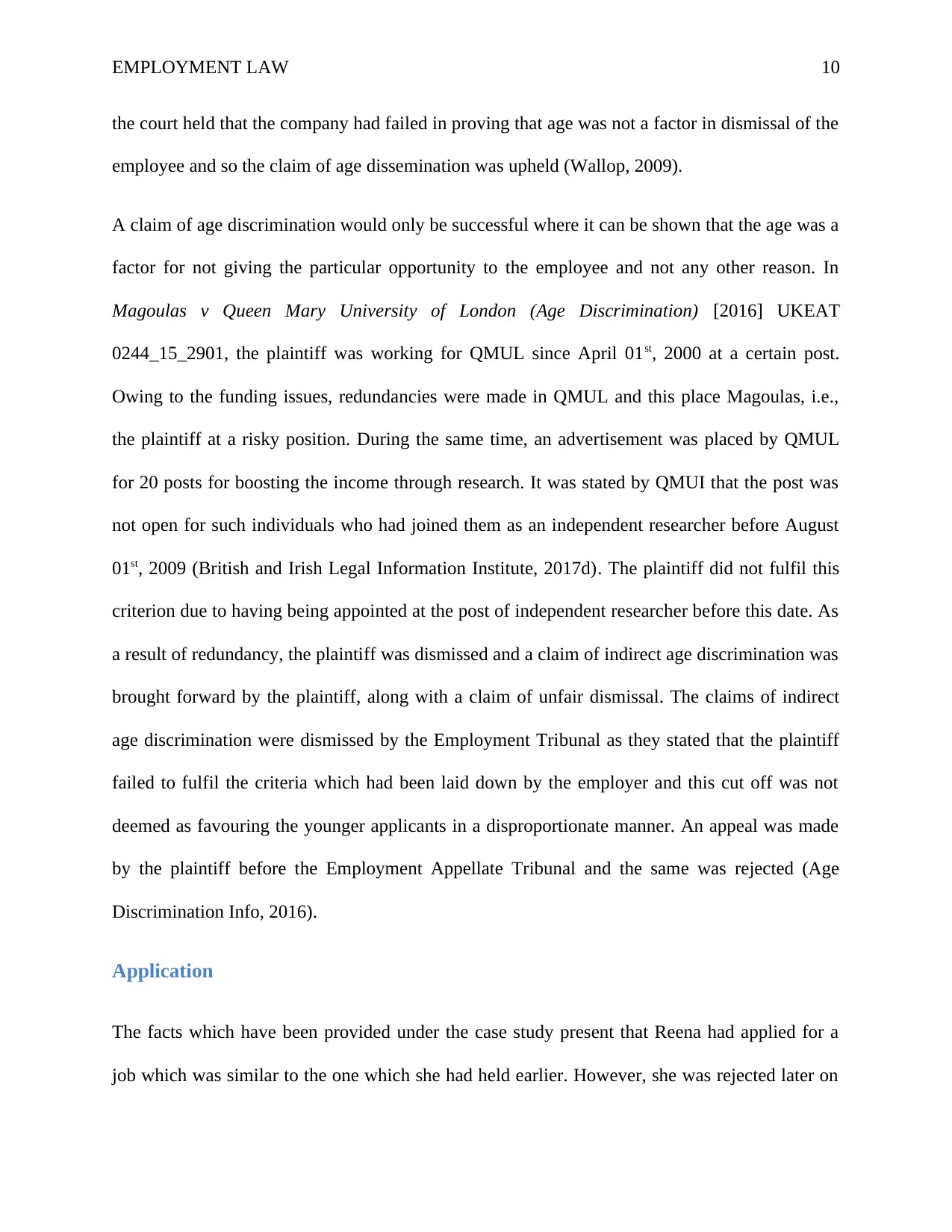
EMPLOYMENT LAW 10
the court held that the company had failed in proving that age was not a factor in dismissal of the
employee and so the claim of age dissemination was upheld (Wallop, 2009).
A claim of age discrimination would only be successful where it can be shown that the age was a
factor for not giving the particular opportunity to the employee and not any other reason. In
Magoulas v Queen Mary University of London (Age Discrimination) [2016] UKEAT
0244_15_2901, the plaintiff was working for QMUL since April 01st, 2000 at a certain post.
Owing to the funding issues, redundancies were made in QMUL and this place Magoulas, i.e.,
the plaintiff at a risky position. During the same time, an advertisement was placed by QMUL
for 20 posts for boosting the income through research. It was stated by QMUI that the post was
not open for such individuals who had joined them as an independent researcher before August
01st, 2009 (British and Irish Legal Information Institute, 2017d). The plaintiff did not fulfil this
criterion due to having being appointed at the post of independent researcher before this date. As
a result of redundancy, the plaintiff was dismissed and a claim of indirect age discrimination was
brought forward by the plaintiff, along with a claim of unfair dismissal. The claims of indirect
age discrimination were dismissed by the Employment Tribunal as they stated that the plaintiff
failed to fulfil the criteria which had been laid down by the employer and this cut off was not
deemed as favouring the younger applicants in a disproportionate manner. An appeal was made
by the plaintiff before the Employment Appellate Tribunal and the same was rejected (Age
Discrimination Info, 2016).
Application
The facts which have been provided under the case study present that Reena had applied for a
job which was similar to the one which she had held earlier. However, she was rejected later on
the court held that the company had failed in proving that age was not a factor in dismissal of the
employee and so the claim of age dissemination was upheld (Wallop, 2009).
A claim of age discrimination would only be successful where it can be shown that the age was a
factor for not giving the particular opportunity to the employee and not any other reason. In
Magoulas v Queen Mary University of London (Age Discrimination) [2016] UKEAT
0244_15_2901, the plaintiff was working for QMUL since April 01st, 2000 at a certain post.
Owing to the funding issues, redundancies were made in QMUL and this place Magoulas, i.e.,
the plaintiff at a risky position. During the same time, an advertisement was placed by QMUL
for 20 posts for boosting the income through research. It was stated by QMUI that the post was
not open for such individuals who had joined them as an independent researcher before August
01st, 2009 (British and Irish Legal Information Institute, 2017d). The plaintiff did not fulfil this
criterion due to having being appointed at the post of independent researcher before this date. As
a result of redundancy, the plaintiff was dismissed and a claim of indirect age discrimination was
brought forward by the plaintiff, along with a claim of unfair dismissal. The claims of indirect
age discrimination were dismissed by the Employment Tribunal as they stated that the plaintiff
failed to fulfil the criteria which had been laid down by the employer and this cut off was not
deemed as favouring the younger applicants in a disproportionate manner. An appeal was made
by the plaintiff before the Employment Appellate Tribunal and the same was rejected (Age
Discrimination Info, 2016).
Application
The facts which have been provided under the case study present that Reena had applied for a
job which was similar to the one which she had held earlier. However, she was rejected later on
Secure Best Marks with AI Grader
Need help grading? Try our AI Grader for instant feedback on your assignments.
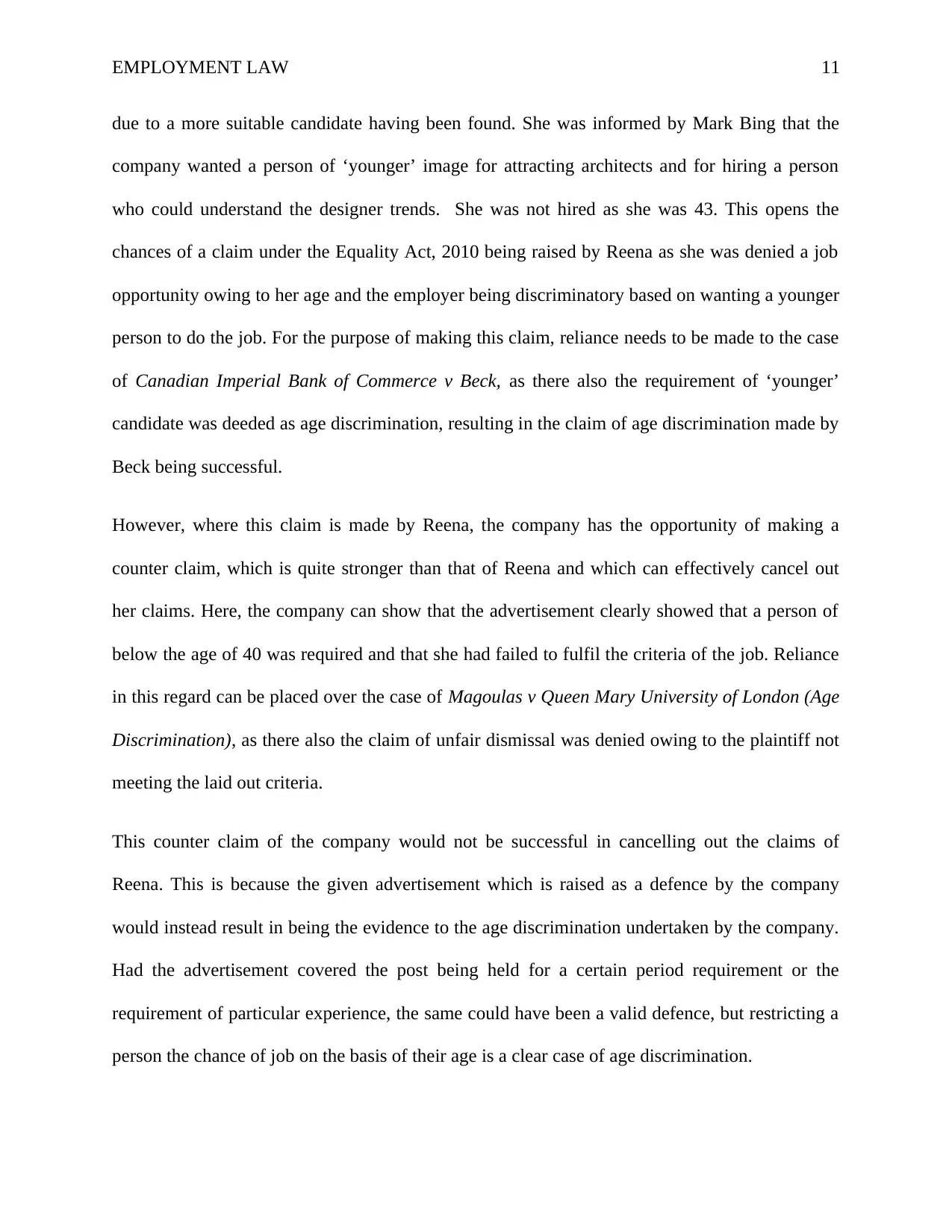
EMPLOYMENT LAW 11
due to a more suitable candidate having been found. She was informed by Mark Bing that the
company wanted a person of ‘younger’ image for attracting architects and for hiring a person
who could understand the designer trends. She was not hired as she was 43. This opens the
chances of a claim under the Equality Act, 2010 being raised by Reena as she was denied a job
opportunity owing to her age and the employer being discriminatory based on wanting a younger
person to do the job. For the purpose of making this claim, reliance needs to be made to the case
of Canadian Imperial Bank of Commerce v Beck, as there also the requirement of ‘younger’
candidate was deeded as age discrimination, resulting in the claim of age discrimination made by
Beck being successful.
However, where this claim is made by Reena, the company has the opportunity of making a
counter claim, which is quite stronger than that of Reena and which can effectively cancel out
her claims. Here, the company can show that the advertisement clearly showed that a person of
below the age of 40 was required and that she had failed to fulfil the criteria of the job. Reliance
in this regard can be placed over the case of Magoulas v Queen Mary University of London (Age
Discrimination), as there also the claim of unfair dismissal was denied owing to the plaintiff not
meeting the laid out criteria.
This counter claim of the company would not be successful in cancelling out the claims of
Reena. This is because the given advertisement which is raised as a defence by the company
would instead result in being the evidence to the age discrimination undertaken by the company.
Had the advertisement covered the post being held for a certain period requirement or the
requirement of particular experience, the same could have been a valid defence, but restricting a
person the chance of job on the basis of their age is a clear case of age discrimination.
due to a more suitable candidate having been found. She was informed by Mark Bing that the
company wanted a person of ‘younger’ image for attracting architects and for hiring a person
who could understand the designer trends. She was not hired as she was 43. This opens the
chances of a claim under the Equality Act, 2010 being raised by Reena as she was denied a job
opportunity owing to her age and the employer being discriminatory based on wanting a younger
person to do the job. For the purpose of making this claim, reliance needs to be made to the case
of Canadian Imperial Bank of Commerce v Beck, as there also the requirement of ‘younger’
candidate was deeded as age discrimination, resulting in the claim of age discrimination made by
Beck being successful.
However, where this claim is made by Reena, the company has the opportunity of making a
counter claim, which is quite stronger than that of Reena and which can effectively cancel out
her claims. Here, the company can show that the advertisement clearly showed that a person of
below the age of 40 was required and that she had failed to fulfil the criteria of the job. Reliance
in this regard can be placed over the case of Magoulas v Queen Mary University of London (Age
Discrimination), as there also the claim of unfair dismissal was denied owing to the plaintiff not
meeting the laid out criteria.
This counter claim of the company would not be successful in cancelling out the claims of
Reena. This is because the given advertisement which is raised as a defence by the company
would instead result in being the evidence to the age discrimination undertaken by the company.
Had the advertisement covered the post being held for a certain period requirement or the
requirement of particular experience, the same could have been a valid defence, but restricting a
person the chance of job on the basis of their age is a clear case of age discrimination.
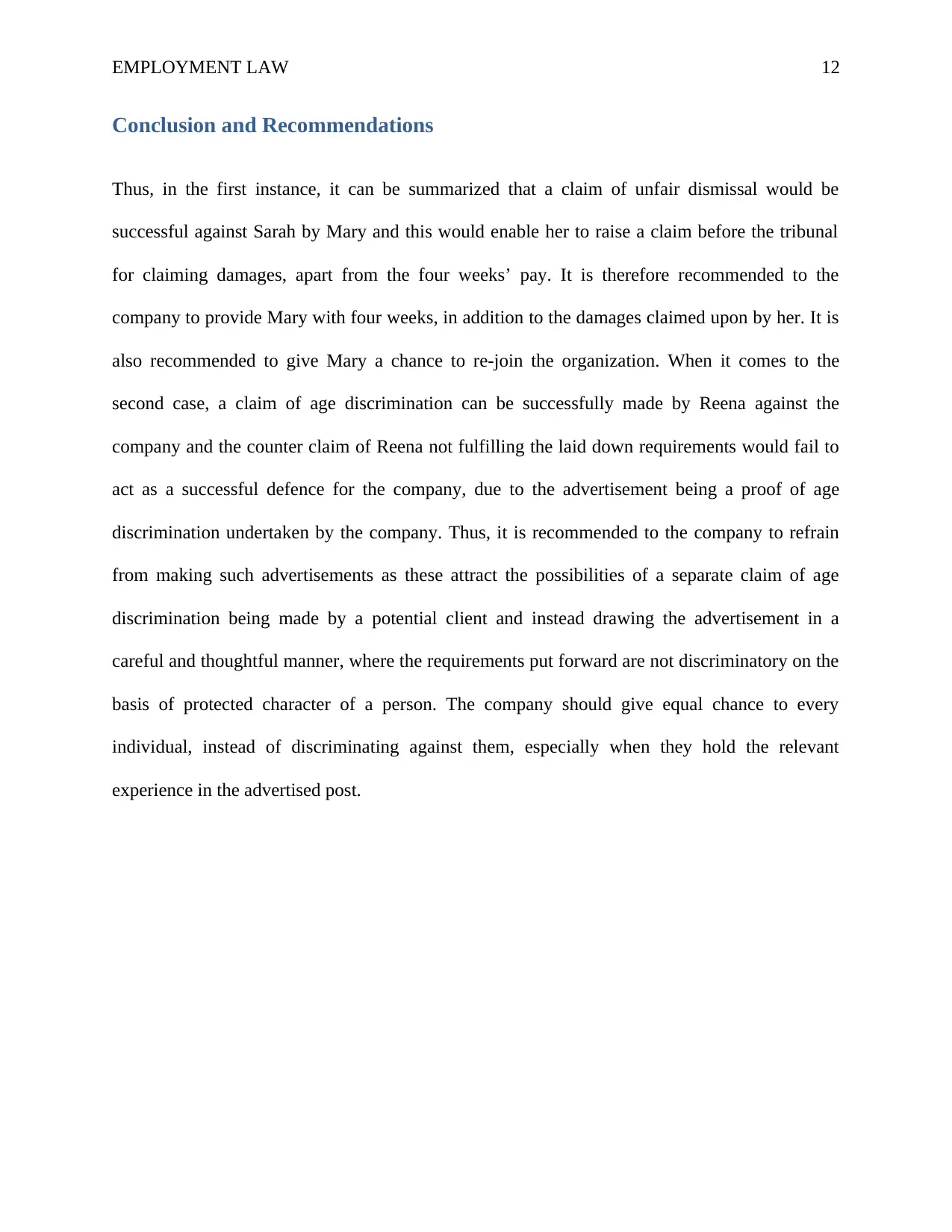
EMPLOYMENT LAW 12
Conclusion and Recommendations
Thus, in the first instance, it can be summarized that a claim of unfair dismissal would be
successful against Sarah by Mary and this would enable her to raise a claim before the tribunal
for claiming damages, apart from the four weeks’ pay. It is therefore recommended to the
company to provide Mary with four weeks, in addition to the damages claimed upon by her. It is
also recommended to give Mary a chance to re-join the organization. When it comes to the
second case, a claim of age discrimination can be successfully made by Reena against the
company and the counter claim of Reena not fulfilling the laid down requirements would fail to
act as a successful defence for the company, due to the advertisement being a proof of age
discrimination undertaken by the company. Thus, it is recommended to the company to refrain
from making such advertisements as these attract the possibilities of a separate claim of age
discrimination being made by a potential client and instead drawing the advertisement in a
careful and thoughtful manner, where the requirements put forward are not discriminatory on the
basis of protected character of a person. The company should give equal chance to every
individual, instead of discriminating against them, especially when they hold the relevant
experience in the advertised post.
Conclusion and Recommendations
Thus, in the first instance, it can be summarized that a claim of unfair dismissal would be
successful against Sarah by Mary and this would enable her to raise a claim before the tribunal
for claiming damages, apart from the four weeks’ pay. It is therefore recommended to the
company to provide Mary with four weeks, in addition to the damages claimed upon by her. It is
also recommended to give Mary a chance to re-join the organization. When it comes to the
second case, a claim of age discrimination can be successfully made by Reena against the
company and the counter claim of Reena not fulfilling the laid down requirements would fail to
act as a successful defence for the company, due to the advertisement being a proof of age
discrimination undertaken by the company. Thus, it is recommended to the company to refrain
from making such advertisements as these attract the possibilities of a separate claim of age
discrimination being made by a potential client and instead drawing the advertisement in a
careful and thoughtful manner, where the requirements put forward are not discriminatory on the
basis of protected character of a person. The company should give equal chance to every
individual, instead of discriminating against them, especially when they hold the relevant
experience in the advertised post.
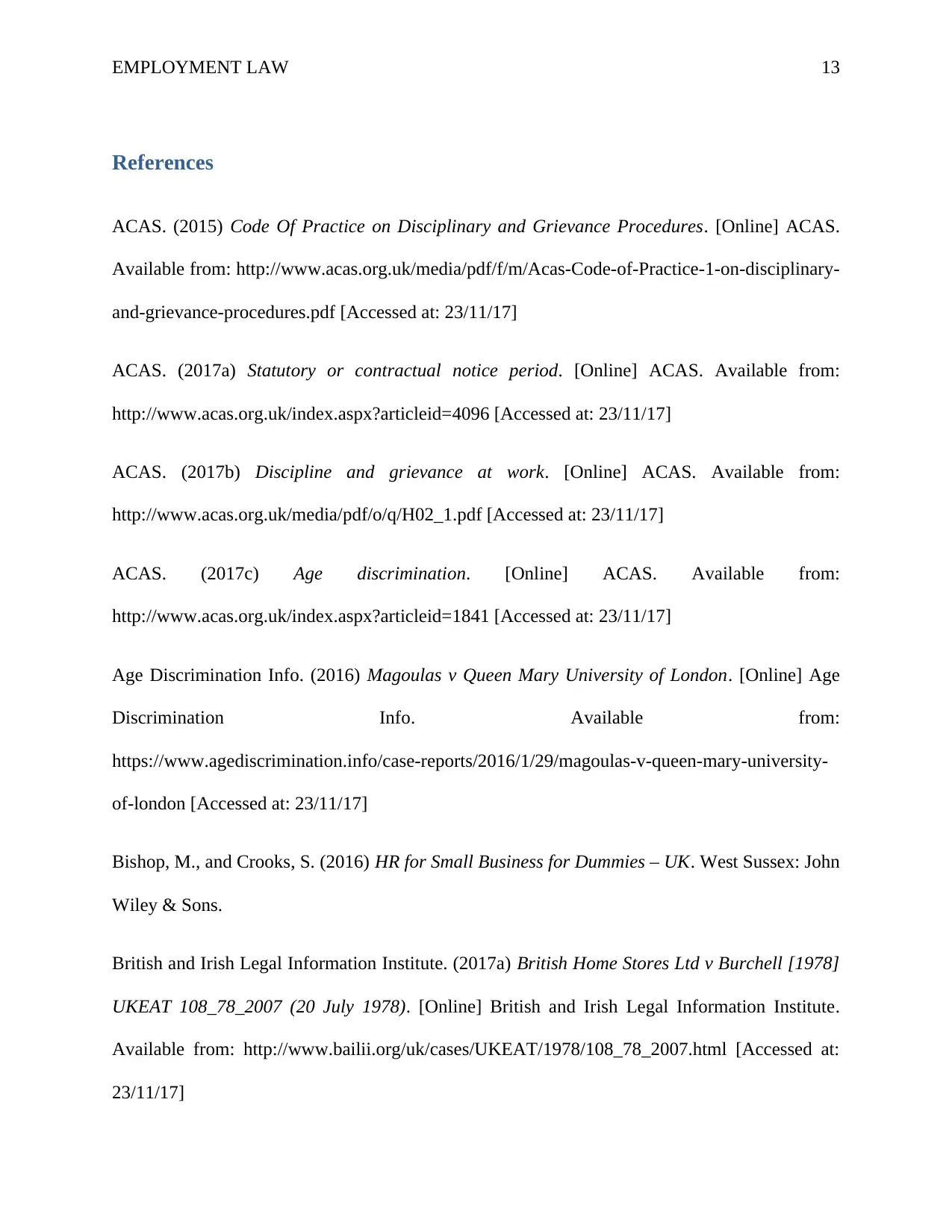
EMPLOYMENT LAW 13
References
ACAS. (2015) Code Of Practice on Disciplinary and Grievance Procedures. [Online] ACAS.
Available from: http://www.acas.org.uk/media/pdf/f/m/Acas-Code-of-Practice-1-on-disciplinary-
and-grievance-procedures.pdf [Accessed at: 23/11/17]
ACAS. (2017a) Statutory or contractual notice period. [Online] ACAS. Available from:
http://www.acas.org.uk/index.aspx?articleid=4096 [Accessed at: 23/11/17]
ACAS. (2017b) Discipline and grievance at work. [Online] ACAS. Available from:
http://www.acas.org.uk/media/pdf/o/q/H02_1.pdf [Accessed at: 23/11/17]
ACAS. (2017c) Age discrimination. [Online] ACAS. Available from:
http://www.acas.org.uk/index.aspx?articleid=1841 [Accessed at: 23/11/17]
Age Discrimination Info. (2016) Magoulas v Queen Mary University of London. [Online] Age
Discrimination Info. Available from:
https://www.agediscrimination.info/case-reports/2016/1/29/magoulas-v-queen-mary-university-
of-london [Accessed at: 23/11/17]
Bishop, M., and Crooks, S. (2016) HR for Small Business for Dummies – UK. West Sussex: John
Wiley & Sons.
British and Irish Legal Information Institute. (2017a) British Home Stores Ltd v Burchell [1978]
UKEAT 108_78_2007 (20 July 1978). [Online] British and Irish Legal Information Institute.
Available from: http://www.bailii.org/uk/cases/UKEAT/1978/108_78_2007.html [Accessed at:
23/11/17]
References
ACAS. (2015) Code Of Practice on Disciplinary and Grievance Procedures. [Online] ACAS.
Available from: http://www.acas.org.uk/media/pdf/f/m/Acas-Code-of-Practice-1-on-disciplinary-
and-grievance-procedures.pdf [Accessed at: 23/11/17]
ACAS. (2017a) Statutory or contractual notice period. [Online] ACAS. Available from:
http://www.acas.org.uk/index.aspx?articleid=4096 [Accessed at: 23/11/17]
ACAS. (2017b) Discipline and grievance at work. [Online] ACAS. Available from:
http://www.acas.org.uk/media/pdf/o/q/H02_1.pdf [Accessed at: 23/11/17]
ACAS. (2017c) Age discrimination. [Online] ACAS. Available from:
http://www.acas.org.uk/index.aspx?articleid=1841 [Accessed at: 23/11/17]
Age Discrimination Info. (2016) Magoulas v Queen Mary University of London. [Online] Age
Discrimination Info. Available from:
https://www.agediscrimination.info/case-reports/2016/1/29/magoulas-v-queen-mary-university-
of-london [Accessed at: 23/11/17]
Bishop, M., and Crooks, S. (2016) HR for Small Business for Dummies – UK. West Sussex: John
Wiley & Sons.
British and Irish Legal Information Institute. (2017a) British Home Stores Ltd v Burchell [1978]
UKEAT 108_78_2007 (20 July 1978). [Online] British and Irish Legal Information Institute.
Available from: http://www.bailii.org/uk/cases/UKEAT/1978/108_78_2007.html [Accessed at:
23/11/17]
Paraphrase This Document
Need a fresh take? Get an instant paraphrase of this document with our AI Paraphraser
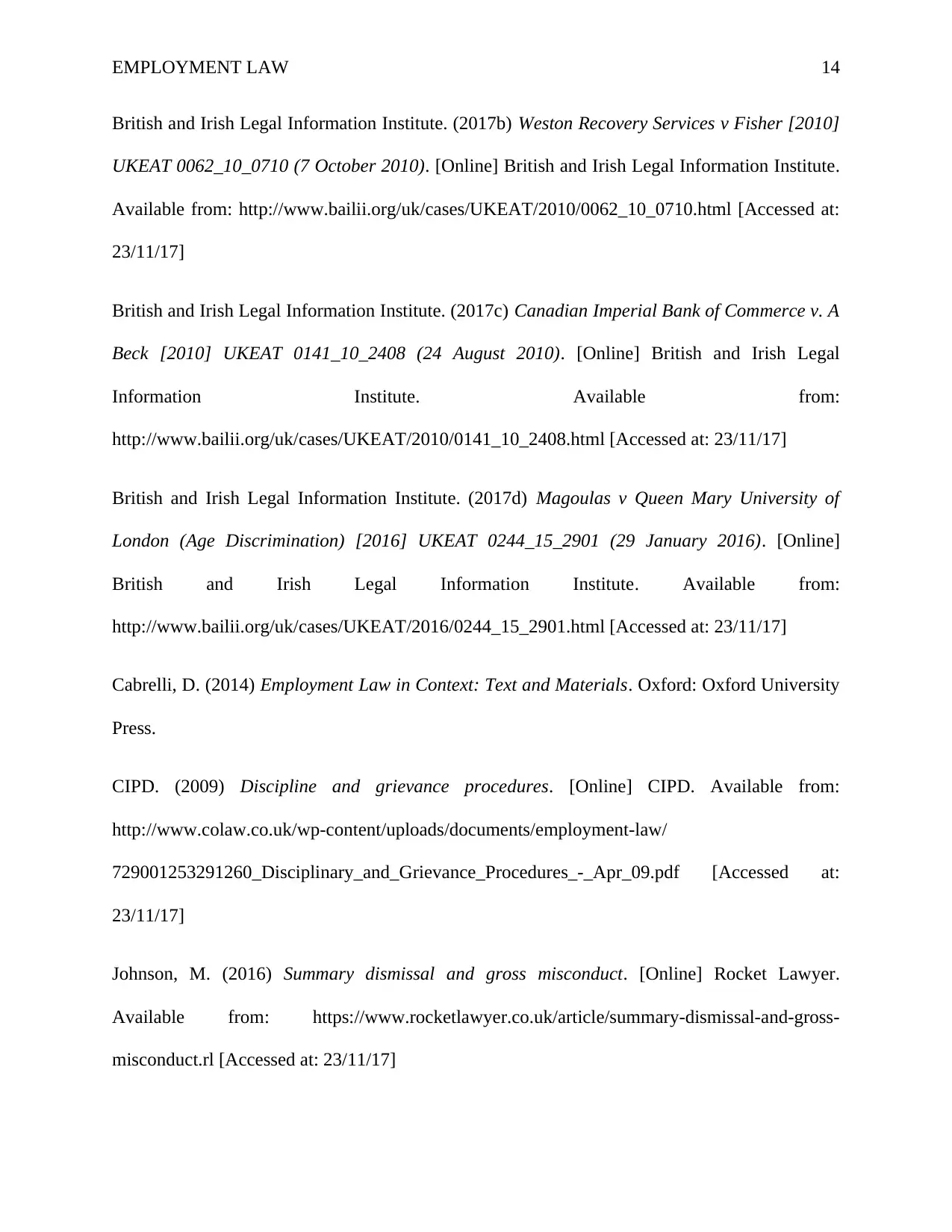
EMPLOYMENT LAW 14
British and Irish Legal Information Institute. (2017b) Weston Recovery Services v Fisher [2010]
UKEAT 0062_10_0710 (7 October 2010). [Online] British and Irish Legal Information Institute.
Available from: http://www.bailii.org/uk/cases/UKEAT/2010/0062_10_0710.html [Accessed at:
23/11/17]
British and Irish Legal Information Institute. (2017c) Canadian Imperial Bank of Commerce v. A
Beck [2010] UKEAT 0141_10_2408 (24 August 2010). [Online] British and Irish Legal
Information Institute. Available from:
http://www.bailii.org/uk/cases/UKEAT/2010/0141_10_2408.html [Accessed at: 23/11/17]
British and Irish Legal Information Institute. (2017d) Magoulas v Queen Mary University of
London (Age Discrimination) [2016] UKEAT 0244_15_2901 (29 January 2016). [Online]
British and Irish Legal Information Institute. Available from:
http://www.bailii.org/uk/cases/UKEAT/2016/0244_15_2901.html [Accessed at: 23/11/17]
Cabrelli, D. (2014) Employment Law in Context: Text and Materials. Oxford: Oxford University
Press.
CIPD. (2009) Discipline and grievance procedures. [Online] CIPD. Available from:
http://www.colaw.co.uk/wp-content/uploads/documents/employment-law/
729001253291260_Disciplinary_and_Grievance_Procedures_-_Apr_09.pdf [Accessed at:
23/11/17]
Johnson, M. (2016) Summary dismissal and gross misconduct. [Online] Rocket Lawyer.
Available from: https://www.rocketlawyer.co.uk/article/summary-dismissal-and-gross-
misconduct.rl [Accessed at: 23/11/17]
British and Irish Legal Information Institute. (2017b) Weston Recovery Services v Fisher [2010]
UKEAT 0062_10_0710 (7 October 2010). [Online] British and Irish Legal Information Institute.
Available from: http://www.bailii.org/uk/cases/UKEAT/2010/0062_10_0710.html [Accessed at:
23/11/17]
British and Irish Legal Information Institute. (2017c) Canadian Imperial Bank of Commerce v. A
Beck [2010] UKEAT 0141_10_2408 (24 August 2010). [Online] British and Irish Legal
Information Institute. Available from:
http://www.bailii.org/uk/cases/UKEAT/2010/0141_10_2408.html [Accessed at: 23/11/17]
British and Irish Legal Information Institute. (2017d) Magoulas v Queen Mary University of
London (Age Discrimination) [2016] UKEAT 0244_15_2901 (29 January 2016). [Online]
British and Irish Legal Information Institute. Available from:
http://www.bailii.org/uk/cases/UKEAT/2016/0244_15_2901.html [Accessed at: 23/11/17]
Cabrelli, D. (2014) Employment Law in Context: Text and Materials. Oxford: Oxford University
Press.
CIPD. (2009) Discipline and grievance procedures. [Online] CIPD. Available from:
http://www.colaw.co.uk/wp-content/uploads/documents/employment-law/
729001253291260_Disciplinary_and_Grievance_Procedures_-_Apr_09.pdf [Accessed at:
23/11/17]
Johnson, M. (2016) Summary dismissal and gross misconduct. [Online] Rocket Lawyer.
Available from: https://www.rocketlawyer.co.uk/article/summary-dismissal-and-gross-
misconduct.rl [Accessed at: 23/11/17]
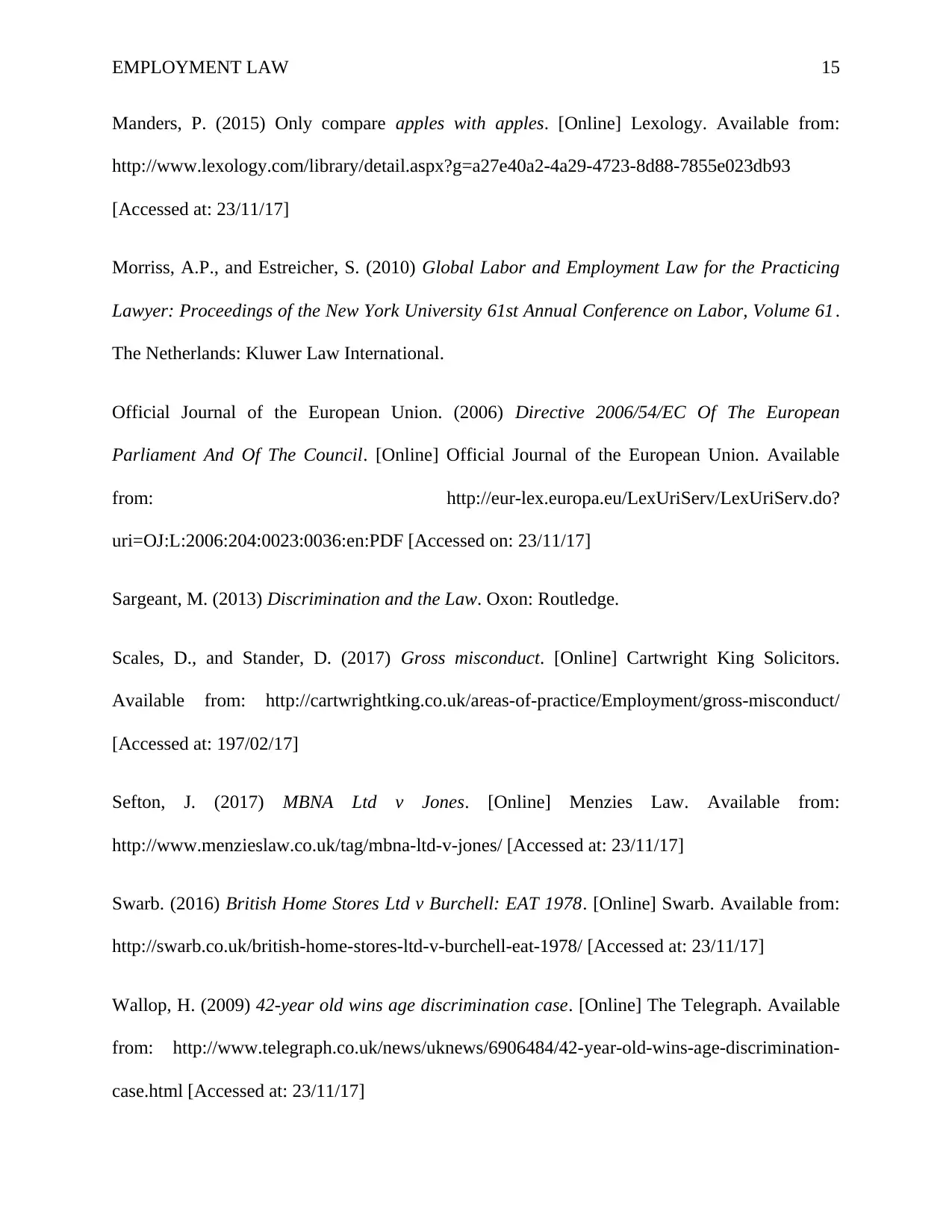
EMPLOYMENT LAW 15
Manders, P. (2015) Only compare apples with apples. [Online] Lexology. Available from:
http://www.lexology.com/library/detail.aspx?g=a27e40a2-4a29-4723-8d88-7855e023db93
[Accessed at: 23/11/17]
Morriss, A.P., and Estreicher, S. (2010) Global Labor and Employment Law for the Practicing
Lawyer: Proceedings of the New York University 61st Annual Conference on Labor, Volume 61.
The Netherlands: Kluwer Law International.
Official Journal of the European Union. (2006) Directive 2006/54/EC Of The European
Parliament And Of The Council. [Online] Official Journal of the European Union. Available
from: http://eur-lex.europa.eu/LexUriServ/LexUriServ.do?
uri=OJ:L:2006:204:0023:0036:en:PDF [Accessed on: 23/11/17]
Sargeant, M. (2013) Discrimination and the Law. Oxon: Routledge.
Scales, D., and Stander, D. (2017) Gross misconduct. [Online] Cartwright King Solicitors.
Available from: http://cartwrightking.co.uk/areas-of-practice/Employment/gross-misconduct/
[Accessed at: 197/02/17]
Sefton, J. (2017) MBNA Ltd v Jones. [Online] Menzies Law. Available from:
http://www.menzieslaw.co.uk/tag/mbna-ltd-v-jones/ [Accessed at: 23/11/17]
Swarb. (2016) British Home Stores Ltd v Burchell: EAT 1978. [Online] Swarb. Available from:
http://swarb.co.uk/british-home-stores-ltd-v-burchell-eat-1978/ [Accessed at: 23/11/17]
Wallop, H. (2009) 42-year old wins age discrimination case. [Online] The Telegraph. Available
from: http://www.telegraph.co.uk/news/uknews/6906484/42-year-old-wins-age-discrimination-
case.html [Accessed at: 23/11/17]
Manders, P. (2015) Only compare apples with apples. [Online] Lexology. Available from:
http://www.lexology.com/library/detail.aspx?g=a27e40a2-4a29-4723-8d88-7855e023db93
[Accessed at: 23/11/17]
Morriss, A.P., and Estreicher, S. (2010) Global Labor and Employment Law for the Practicing
Lawyer: Proceedings of the New York University 61st Annual Conference on Labor, Volume 61.
The Netherlands: Kluwer Law International.
Official Journal of the European Union. (2006) Directive 2006/54/EC Of The European
Parliament And Of The Council. [Online] Official Journal of the European Union. Available
from: http://eur-lex.europa.eu/LexUriServ/LexUriServ.do?
uri=OJ:L:2006:204:0023:0036:en:PDF [Accessed on: 23/11/17]
Sargeant, M. (2013) Discrimination and the Law. Oxon: Routledge.
Scales, D., and Stander, D. (2017) Gross misconduct. [Online] Cartwright King Solicitors.
Available from: http://cartwrightking.co.uk/areas-of-practice/Employment/gross-misconduct/
[Accessed at: 197/02/17]
Sefton, J. (2017) MBNA Ltd v Jones. [Online] Menzies Law. Available from:
http://www.menzieslaw.co.uk/tag/mbna-ltd-v-jones/ [Accessed at: 23/11/17]
Swarb. (2016) British Home Stores Ltd v Burchell: EAT 1978. [Online] Swarb. Available from:
http://swarb.co.uk/british-home-stores-ltd-v-burchell-eat-1978/ [Accessed at: 23/11/17]
Wallop, H. (2009) 42-year old wins age discrimination case. [Online] The Telegraph. Available
from: http://www.telegraph.co.uk/news/uknews/6906484/42-year-old-wins-age-discrimination-
case.html [Accessed at: 23/11/17]
1 out of 15
Related Documents
Your All-in-One AI-Powered Toolkit for Academic Success.
+13062052269
info@desklib.com
Available 24*7 on WhatsApp / Email
![[object Object]](/_next/static/media/star-bottom.7253800d.svg)
Unlock your academic potential
© 2024 | Zucol Services PVT LTD | All rights reserved.





